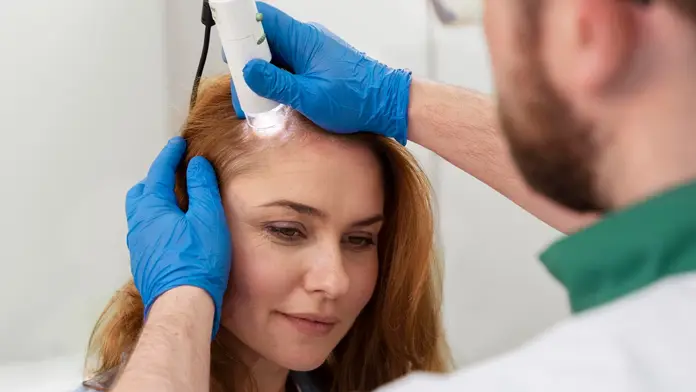Overview
Hair loss is one of the most severe lifestyle issues that people face nowadays. Hair loss affects one out of every three people at some point in their lives, and it can have a substantial influence on their quality of life. Hair loss is normal as a result of genetics, stress, diet, or aging. As a result, it is critical to detect hair loss early and contact a hair expert. Remember that prevention is better than cure when looking for the best hair loss treatment!
Risk Factor
Are you worried about losing your hair? Are you looking for the best hair loss treatment for female or men? To discover the underlying reason for your hair loss and develop a suitable hair regrowth treatment strategy, make reach out to the skilled dermatologists at AAYNA. The team of highly qualified and experienced professionals at AAYNA can provide a personalized assessment, recommend appropriate hair fall treatment, and provide cost information depending on your individual needs.
Precursors To Hair Loss In Women
Hair loss in women can be caused by a variety of factors. Here are some common precursors to hair fall in women:
Hormonal Changes: Hormonal variations in women might contribute to hair loss. Changes in the hair growth cycle caused by fluctuations in hormones due to pregnancy, childbirth, menopause, or even hormonal diseases such as polycystic ovarian syndrome (PCOS) can cause greater shedding.
Genetic Factors: Family history and genetics both play an important part in hair loss. Women who have a family history of androgenetic alopecia (female pattern baldness) are predisposed to hair loss.
Nutritional Deficiencies: Hair loss can be exacerbated by a lack of key nutrients, including iron, zinc, biotin, and vitamins (such as vitamin D and vitamin B12). A nutritious diet is essential for sustaining good hair growth.
Stress and Emotional Factors: Emotional stress, trauma, and continuous periods of stress can all contribute to hair loss in women. Stress-induced conditions such as telogen effluvium cause a significant number of hair follicles to enter the resting phase at the same time, resulting in excessive shedding.
Excessive use of heat styling equipment, tight hairstyles (such as ponytails, braids, or buns), chemical treatments (such as perming or coloring), and poor hair care practices can all damage the hair shaft and cause hair breakage and loss.
Precursors To Hair Loss In Men
Some common precursors to hair fall in men:
Androgenetic Alopecia (Male Pattern Baldness): Androgenetic alopecia, also known as male pattern baldness, is the most prevalent cause of hair loss in men. Genetic factors and hormonal changes, notably the effect of dihydrotestosterone (DHT) on hair follicles, are the primary determinants.
Hormonal Factors: Hormonal imbalances or variations can cause male hair loss. Increased levels of DHT, a testosterone derivative, can cause hair follicles to shrink, resulting in thinner and shorter hair growth.
Aging: Hair loss becomes more prevalent in men with aging. As men age, their hair development cycle slows and their hair follicles become less prolific, resulting in progressive hair thinning and loss.
Medical disorders and Treatments: Certain medical disorders and treatments might cause men to lose their hair. Thyroid issues, autoimmune diseases, scalp infections, and chronic ailments are examples. Furthermore, radiation therapy, chemotherapy, and certain drugs might result in either short-term or long-term hair loss.
Scalp problems: such as seborrheic dermatitis, scalp psoriasis, or fungal infections, can disrupt the hair development cycle and cause male hair loss.
It’s important to remember that the precise cause of hair loss in males might vary, and an appropriate diagnosis requires a proper evaluation by a healthcare professional, such as a dermatologist or trichologist such as at AAYNA’s. They can evaluate your specific case, do any necessary tests, and provide suitable counsel and the best hair loss treatment for male as well as females.
Hair Loss Treatment
It is critical to see a reputable dermatological clinic and hair restoration center for your hair growth treatment. The cost and specific methods available vary depending on the clinic, the extent and cause of the hair loss, and the particular hair regrowth treatment plan.
Here are some of the most common hair fall treatment options:
Hair loss medication: Minoxidil and finasteride and other such hair loss medication may be used to minimize hair loss, stimulate hair regrowth, or treat underlying hair loss diseases.
PRP (Platelet-Rich Plasma) Therapy: A little amount of blood is taken, processed, and then injected into the scalp to stimulate hair growth.
Mesotherapy: is the injection of vitamins, minerals, and medications into the scalp to nourish and stimulate hair follicles.
Low-Level Laser Therapy: Using low-level laser devices or combs, this hair treatment for hair loss stimulates hair follicles and promotes hair regrowth.
Hair Patches: Hair patching is one of the most used artificial hair restoration procedures. It is such a successful method of hair regeneration that many people prefer it over a hair transplant, which is a pricey surgical hair fall solution. A skin-friendly cosmetic glue and skin-friendly clips are utilized during this hair regrowth to fix a hair patch or wig over the injured area.
Scalp Clear Therapy for Dandruff: Dandruff is a common problem that can be embarrassing and difficult to treat. Scalp clear therapy is a revolutionary hair fall solution that uses natural chemicals to eradicate dandruff and prevent it from returning. This therapy is suitable for all skin types and is particularly effective in removing dandruff.
Hair transplant surgery: For people experiencing severe hair loss, hair transplant surgery can be another option. Hair follicles are taken from a donor site and transplanted to places where hair is thinning or receding.
Cost Of Hair Loss Treatment In India
The cost of hair loss treatment in India varies according to a number of criteria, including the type of hair growth treatment, the level of hair loss, the clinic or hospital chosen, the experience of the healthcare professional, and the location within India. Here are some ballpark figures for common hair loss treatments in India.:
Hair loss medication: The cost of prescription hair loss medication such as finasteride or minoxidil can range from INR 500 to INR 2,000 each month, depending on the brand and dosage.
Platelet-Rich Plasma (PRP) Therapy: Platelet-rich plasma produced from the patient’s blood is injected into the scalp to encourage hair growth. PRP therapy sessions might cost between INR 5,000 and INR 20,000 per session. For best results, many sessions may be required.
Hair transplant: techniques entail collecting hair follicles from the donor area and transplanting them to areas of hair loss. The cost of hair transplant surgery varies depending on the procedure employed (such as follicular unit extraction [FUE] or follicular unit transplantation [FUT]), the number of grafts necessary, and the reputation and location of the facility. The cost might range from INR 50,000 to INR 3,00,000 or more on average.
SMP (Scalp Micropigmentation): SMP is a non-surgical cosmetic procedure that includes tattooing the scalp to simulate hair follicles. SMP can cost anywhere from INR 50,000 to INR 2,000,000 or more in India, depending on the degree of the therapy and the clinic’s billing system.
Low-Level Laser Therapy (LLLT): LLLT is a non-invasive treatment that stimulates hair growth by using low-level laser devices or combs. LLLT sessions can cost between INR 2,000 and INR 5,000 each session, with repeated sessions recommended for best outcomes.
It is crucial to note that these price ranges are estimates and may vary depending on individual circumstances and geographical areas. To obtain precise information about the specific hair thinning treatment options, their costs, and any additional fees involved, it is recommended that you visit specialized clinics offering hair loss treatment for men and women.
Factors Affecting the Cost Of Hair Loss Treatment In India
Several factors can influence the cost of hair loss therapy in India. Here are some important cost-influencing factors:
Treatment Type: The cost of various hair loss treatments varies. drugs, such as oral drugs or topical solutions, are often less expensive than surgical procedures such as hair transplants or advanced therapies such as PRP therapy or laser therapy.
Clinic Reputation and Expertise: The cost of the best hair loss treatment can be influenced by the clinic’s or healthcare provider’s reputation and expertise. Well-established clinics with knowledgeable and well-known doctors may charge more for their services.
Treatment Intricacy and Extent of Hair Loss: The cost is affected by the treatment’s intricacy and the extent of hair loss. In hair transplant surgeries, for example, the number of grafts required and the technique utilized (FUE or FUT) might affect the cost.
Personalization and customization: Some therapies may necessitate personalization depending on individual needs and goals. Customizing the treatment plan to meet unique needs can raise the final cost.
Technology and Equipment: The employment of new technology, equipment, and facilities during treatment can have an impact on the cost. Cutting-edge technologies or devices may incur additional costs.
Takeaway
To make an informed selection, it is best to visit a reputable clinic to discuss specific treatment options and associated expenses, as well as acquire complete information about the services provided. Furthermore, examining the healthcare provider’s skill and reputation is critical to ensuring safe and effective treatment outcomes.
At AAYNA, our skilled hair Doctors will provide not only the best hair regrowth for men and women but also customized hair solutions for your specific hair needs and issues, as well as advice on hair management to restore your hair to its healthiest state.
Frequently Asked Questions
- How long does it take for hair fall treatments to produce results?
The time it takes to see the effects of hair loss treatments varies depending on the treatment method used and the individual’s response. The transplanted hair may take 6 to 12 months or longer to properly grow and blend with the existing hair. Individual reactions can vary, so it’s vital to have reasonable expectations and be patient with the treatment process.
2. Is hair loss treatment for women safe?
When used correctly and under the supervision of a healthcare practitioner, most hair loss therapies are considered safe for women. However, before beginning any treatment, it is critical to consult with a skilled dermatologist. They may examine your specific disease, weigh the risks and advantages of treatment alternatives, and propose the best approach based on your specific needs.
3. What is the most effective hair loss treatment for women?
Hair loss therapies for women, like hair loss treatments for men, vary depending on the kind of hair loss. AAYNA provides hair loss treatment for both men and women, with consistent, guaranteed results.
4. Is Dandruff a Cause of Hair Loss?
Dandruff, also known as seborrhoeic dermatitis, is an inflammatory condition of the scalp and hair follicles. This causes an itching scalp and hair loss. High atmospheric humidity, especially during the monsoon season, promotes the production of oil from the scalp and exacerbates the dandruff condition. Another explanation is why hair fall often intensifies during the monsoon season.


